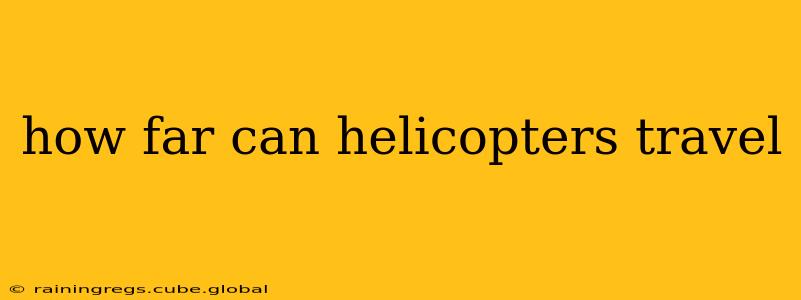Helicopters, known for their vertical takeoff and landing capabilities, are versatile aircraft used for a variety of purposes, from search and rescue to cargo transport and even luxury travel. But a question frequently arises: how far can a helicopter actually travel? The answer, unfortunately, isn't a simple number. The distance a helicopter can cover depends on several critical factors. This guide will explore those factors and provide a comprehensive understanding of helicopter range.
What Factors Determine a Helicopter's Range?
Several interconnected elements influence a helicopter's maximum range. Let's break them down:
-
Helicopter Model and Size: Larger helicopters with bigger fuel tanks naturally have a longer range than smaller models. A heavy-lift helicopter like a CH-53K will travel significantly farther than a light utility helicopter like an R-44. The design of the rotor system and the airframe also impacts fuel efficiency.
-
Fuel Capacity: This is perhaps the most straightforward factor. More fuel equates to a greater potential distance. However, carrying more fuel also adds weight, which affects fuel consumption.
-
Payload: The weight of passengers, cargo, and equipment significantly impacts fuel efficiency. A fully loaded helicopter will consume fuel faster and thus have a shorter range than an empty one. This is why range specifications are often given for specific payload weights.
-
Weather Conditions: Headwinds decrease range, while tailwinds increase it. Turbulence also impacts fuel consumption, as the helicopter needs to work harder to maintain stability. Adverse weather can shorten the effective range considerably.
-
Altitude: Flying at higher altitudes requires more power, thus increasing fuel burn and reducing range. Thin air at higher altitudes reduces the lift generated by the rotor blades.
-
Terrain: Flying over mountainous terrain or densely forested areas requires more power due to increased drag, reducing the overall range.
-
Pilot Technique: A skilled pilot can optimize fuel consumption through careful flight planning and efficient piloting techniques, maximizing the helicopter's range.
How Far Can Different Types of Helicopters Travel?
Providing exact figures for helicopter range is difficult without specifying the model, payload, and flight conditions. However, we can offer some general ranges for different classes:
-
Light Helicopters: These typically have ranges from 200 to 500 nautical miles (370 to 926 kilometers) depending on the model and payload.
-
Medium Helicopters: These often have ranges from 300 to 700 nautical miles (556 to 1296 kilometers), again, depending on the variables mentioned above.
-
Heavy Helicopters: These can boast ranges exceeding 700 nautical miles (1296 kilometers), but this can be significantly reduced with heavy loads or adverse conditions.
What About Extended Range Helicopters?
Manufacturers are constantly striving to improve helicopter range. Some designs incorporate features like:
- Larger Fuel Tanks: Obvious but effective, allowing for more fuel storage.
- More Efficient Engines: Technological advancements lead to better fuel efficiency.
- Improved Aerodynamics: Streamlining the design reduces drag and increases range.
How Do Helicopters Refuel in Flight?
While not common for most helicopter operations, aerial refueling is a possibility for military and specialized civilian helicopters. This allows for significantly extended range capabilities.
H2: What is the average range of a helicopter?
There's no single "average" range for a helicopter. It varies greatly depending on the factors discussed above. To get an accurate estimate for a specific mission, you must consult the flight manual for the specific helicopter model.
H2: Can helicopters fly across the ocean?
While some helicopters have the potential range to theoretically cross an ocean, it's rarely done due to several challenges:
- Lack of Refueling Infrastructure: There are limited options for mid-ocean refueling for helicopters.
- Weather Risks: Ocean crossings are susceptible to unpredictable and potentially dangerous weather.
- Emergency Response Limitations: An emergency over open water is far more challenging than over land.
Though technically possible for some specialized models, ocean crossings are extremely rare and risky for helicopters.
H2: How far can a helicopter fly without refueling?
The distance a helicopter can fly without refueling entirely depends on the variables described earlier – the type of helicopter, payload, weather, and pilot skill. It can range from a few hundred to over a thousand kilometers. Always refer to the aircraft's flight manual for accurate information.
In conclusion, understanding how far a helicopter can travel requires careful consideration of numerous factors. While manufacturers specify ranges, those numbers serve as guidelines. Actual range depends on the specific circumstances of each flight. Consulting the flight manual for the relevant helicopter model is crucial for precise range estimates.
